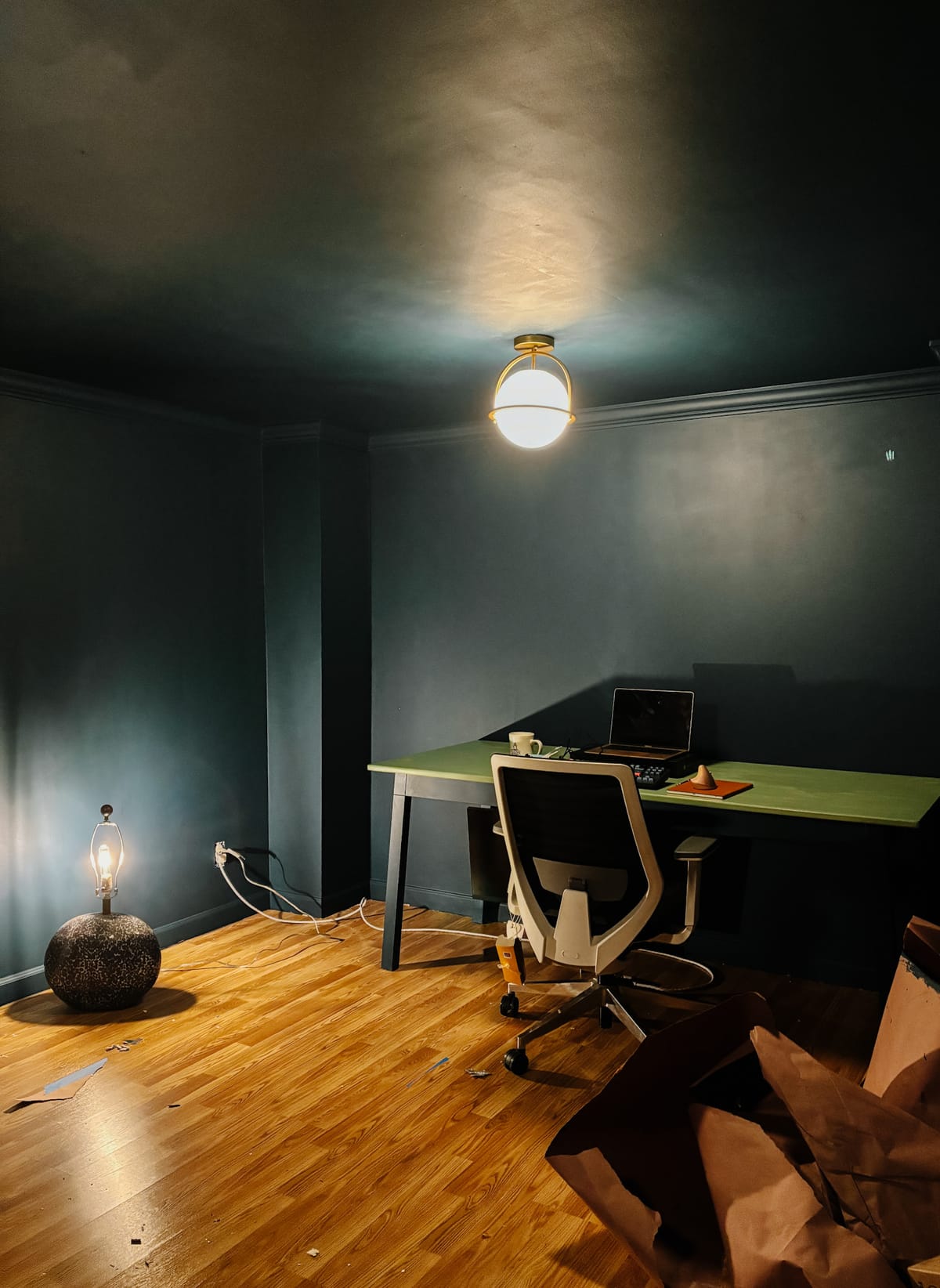Above the lintel
and through the wall

Just a quick note! Some paid subscribers didn't get their October Pocket Observance yesterday! It's a list glitch. I am sorting through the emails right now. Expect your observance by end of day. (If you haven't gotten it already!) - meg
Last month, I decided to turn a little basement storage room into an office. It was a cold, dark space. The HVAC doesn’t seem to be hooked up to the vent in the ceiling. And there are no windows. A space heater can fix the first problem. But the issue of light has been more difficult to address.
Bright overhead lighting gives me migraines. Very Joe vs The Volcano of me, I know. When I looked up “depressing windowless office,” several blogs suggested I DIY a fake window. But I think the only thing more depressing than not having a window might be pretending to have a window? Or I did, until I found CoeLux.
CoeLux is a luxury lighting brand that promises its virtual window products can “replicate the beauty of sunlight and the infinite sky” inside your home, retail or office space!This is no small thing. Sunlight is very difficult to reproduce.
Before it reaches our eyes, sunlight passes through the atmosphere where air molecules scatter wavelengths of visible light. This is called Rayleigh scattering. Blue lightwaves scatter more than red light waves and so the sky looks blue.
Coelux uses nanotechnology to scatter LED in the same patterns created by Rayliegh scattering. Their skylights can be programmed to replicated sunlight as it appears at different points in the day, in different points in the world. You could order an Nordic sun for your Italian villa, if you wanted.
What are the limits of this light simulation? Can I order sunlight from Corona Del Mar, filtered through the atmosphere of a summer day in 1993? If so I could write under light I last experienced as an eight year old, when I could still hold my father’s hand. I wonder what I could see in that light now, that I couldn’t see then.
People who move through spaces lit by CoeLux describe the experience as something approaching inter-dimensional. I’ll have to take their word for it. This virtual showroom is as close as I’ll get. The company’s smallest product is $35,000 before installation.
So I’ve decided to lean into the lack of light. I’ll pretend I’m writing in the belly of a space-faring or sea-faring or something-faring vessel. Pain the walls dark enough to mimic expanse. Fill underlit shelves with books, specimens and terrariums. A daybed piled with gothic textiles. It’s nice in my head. In reality, well…I ran out of money after I painted the walls and a table from Ikea. So instead of feeling like I am in the belly of something, I feel like I am where I am - a cold, dark room in my basement.
I can’t stop thinking about windows and what streams through them.
As far as we can tell, windows are as old as enclosed living spaces. The first windows were holes in the roof, a place to let smoke out and a little light in. Eventually, windows made their way down to the sides of our dwellings.
They were still used for ventilation, but now they could also helps us see outside too. In many languages the word for window contains the word for ‘eye.’ Take the word ‘window!’ It means ‘wind eye,’ coming from the Old Norse vindr (wind) and auga (eye).
What could be the connection between “windows”, whose main functions are to admit light and air, and “eyes”? To answer this, we need to go over how we think about “eyes”. Our eyes are organs that enable us to perceive and receive information from the external world. If we think about it this way, the human body is a closed entity that has a distinct inside and outside, and the eyes can be described as “holes” in the body. The Anglo-Saxons likened houses to human bodies and described windows as “eagdyrel” (or “Augenloch” in modern German, both with the literal meaning “eye-hole”). The sides of a house on which windows are set are still described as “faces” as well. Just as the eyes are essential sensory organs for ensuring the human bodyʼs connection to the external world, windows connect the closed spaces of a house with its external environment.
Yasunari Ueda, Window Research Institute
Windows are a kind of technology. They were invented to create and manage a connection between our shelter and the environment that’s moved us to seek shelter. Like string, the window is an invention that’s never been disrupted.
The materials we’ve used to cover the window goes through changes - woven mats, metal, paper, glass! But the window itself - that hole in the wall, that ancient Wind Eye- is a stable dimension. Innovations like electric lights and air purifiers assist with illumination and ventilation. But we are still profoundly dependent on windows to manage the connection between our inside and outside environments. This is not without consequence.
Take the Window Tax William III passed in 1696. Let me set the scene for you.
The Crown was deeply in debt. Oppressing the Irish, fighting the French and reinforcing mercantalism wasn’t cheap, you know? Paying the debt off was difficult because England was in the middle of a commodity currency crisis.
The face value of England’s coins was less than their value once melted down into bullion. This was aggravated by coin clipping - shaving, shaking, soaking and cutting bits of precious metal from coins in order to make “counterfeit” coins. Commodity currency derives value from its weight and fineness. A clipped coin was technically worth less than its face value. Clipping coins is a kind of currency debasement. It was a crime punishable by death.
The English government regularly debased its currency with base metals. Kind of like how my grandma added peas to leftover to stretch them? But only kind of. Because my grandma was stretching the leftovers to keep us fed. And the Mint was stretching currency to fund wars.
It is okay to debase a currency to pay for war. But it is not okay to debase a currency to pay for food. Got it? - The Government, usually.
The Crown blamed coin clipping for the state of England’s purse. A tax was needed to “make good the Deficiency of the clipped Money.” The elites claimed an income tax would violate their privacy. Their income was nobody’s business! So the Window Tax used information that the government agent could get while standing out on the street - the number of windows in each dwelling. Houses with more than ten windows were taxed for each additional window. Any opening used for ventilation or light was counted as a window.
Proponents of the Window Tax claimed it would only impact the wealthy. But it devastated the urban poor. Tenement buildings were considered one dwelling and taxed accordingly. Landlords bricked up windows and grates to minimize their tax burden. The air inside the buildings became heavy with small particulates from cooking and warming fires. Disease spread. Children died in the dark in the middle of the day because natural light had become a luxury. It was more costly to rent a home with an adequate number of windows. Landlords simply passed their increased tax burden onto their tenants.
While landlords covered windows, William III oversaw The Great Recoinage. All of the old coins were collected, melted down and minted into new coins. They new coins were rolled through a heavily guarded machine that forced an anti-counterfeit design into each one - milled edges. The engraved edges of our own cons are a legacy of this innovation.
Records indicate that fully half of the late 17th-century coin clippers were poor women struggling to feed their children. They were incredibly innovative, designing processes that produced near-perfect coins. Many of those women lived in cities because Acts of Enclosure cut away at the Commons until it could not sustain its commoners. Unlike coin clipping, commons clipping has always been legal.
Furthermore, today we can see that the concept of the window has been expanded to also describe things such as computer monitors, which allow us to look out into the worlds of virtual reality.
Yasunari Ueda, Window Research Institute
The window tax was eventually repealed. But the enclosure of the commons and the minting of means of survival continues. Especially in America.
Men in tech get to clip the commons, debasing our time, ideas, and potential futures. Conglomerates get to clip the commons, extracting fossil fuels so that it can warm the waters that sweep us away. JD Fucking Vance gets to clip the commons, instituting a national abortion ban enforced via digital peeping toms.
In the age of climate change and surveillance capitalism, the powerful get to shut up their windows to keep from being poisoned by toxic clouds, surveilled by AI hype-machinists. The rest of us are exposed. It makes me want to hide in a place with no windows.
But then there is something that almost feels worth noting. Some scholars think proto-windows functioned as doors and pronto-doors unctioned as windows. At some point, the window and the door diverged. But it’s possible early conceptions of window - including Old Norse’s Wind Eye - co-existed with the window that is also an entrance.
This is interesting to consider within the context of a people who spoke Old Norse. The Vikings believed the thresholds of a dwelling were liminal spaces. A woman could peer above the lintel of a door, or above the lintel of an object constructed to look like a door, and see a different world. She’d shout down what she saw.
And I find myself wondering - just a little - if I’ve spent too much time thinking about what streams through windows and too little time considering what might lie just beyond the window frame. Maybe I’ll try out one of those faux window DIYs after all. I could hang it on the wall, climb up on my Ikea table, and peer above the lintel. Maybe I will see a different world. Maybe I will feel its wind on my face.

